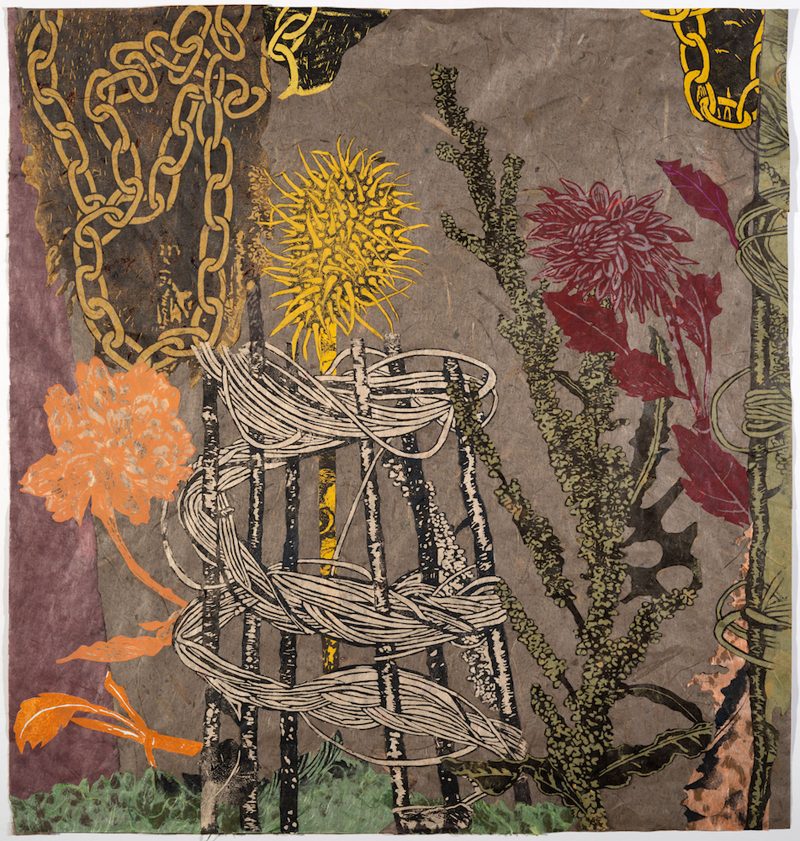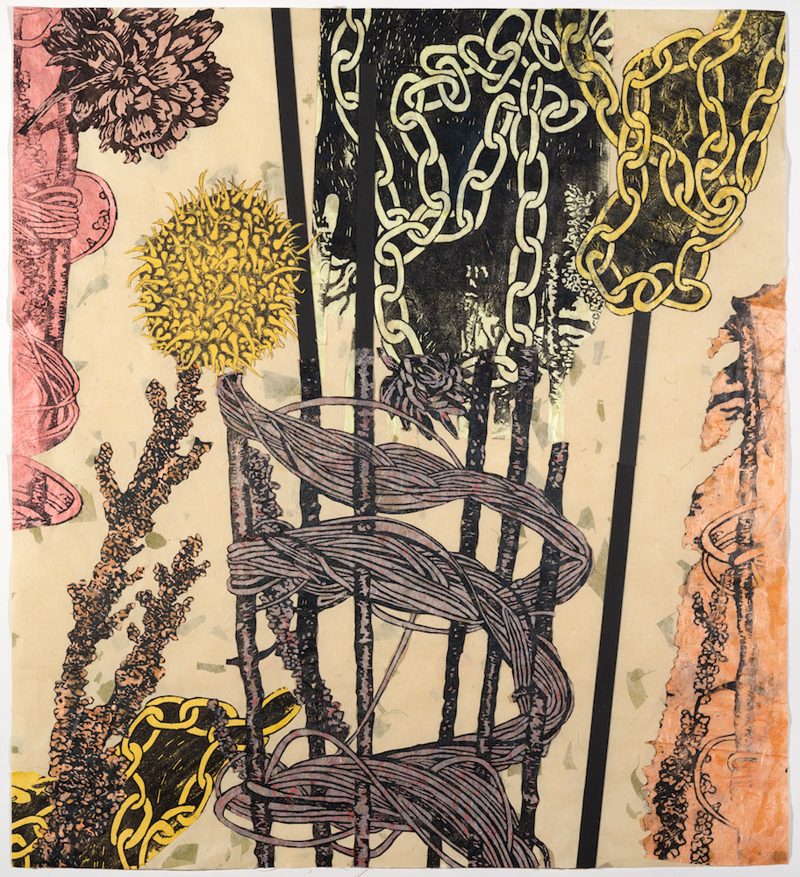Joan Wadleigh Curran’s show at the C.R. Ettinger Studio,
Recombinants, is not a series of works that uses depictions of plants and other flora to make a statement about climate change, or one that places images of dead blossoms into some vanitas-style context about human nature. It’s simply about what it is–the recursive, fragile, and ultimately stubborn forms of nature that continue to appear around us in all sorts of settings. Curran’s works stand on their own as tributes to, and explorations of, the way natural forms link us all together by occurring and recurring throughout history, place, and time.
 |
| “Construction V” 2019, Joan Wadleigh Curran. Etching, woodcut, and collage, 25” x 23 3⁄4”. From “Recombinants” at C. R. Ettinger Studio. |
Recombinants demonstrates subtly and expertly that the same forms in different contexts evoke markedly different moods. Nature appears here in all different forms of plant life, its motifs of blossoms, burrs, thistles, braids, stalks, and leaves repeating and reviving themselves across the different compositions, like the same set of genes twisting in new helices and expressing themselves in new ways every time. The same cut-out blossoms that appear autumnal and hearty in a red-purple-orange palette in works like “Construction XIX” are distinctly funereal set against a gray and black ground in “Construction III.” The same forms then reappear, spring-like and reincarnated against a green ground, in “Construction VI,” creating a sort of through-line among these works that tells the story of what it is–the perpetual, hermetic cycle of nature. The only sign of human impact is the presence of a chain motif in several of the works, perhaps to reinforce the linked-ness of humans and nature.
The works in
Recombinants are a curious mix of media, shown here in their final, collaged form. To an extent, they are the product of a collaborative process between Curran and Ettinger. Curran designs the image, Ettinger prints an edition, and then Curran turns them into collages, combining etchings and woodcuts with drawings all rendered in different colored inks on different shades of paper. Curran uses the inherent properties of etchings and woodcuts–the etchings are delicate, while the woodcuts, naturally, use a thicker line– to create active, engaging, balanced compositions. The installation of
Recombinants was also a product of collaboration between Curran and Ettinger, and while it’s a small detail, the choice to house smaller works with rougher, pulpier edges in a vitrine is unmistakably reminiscent of the experience of viewing botanical specimens under glass. The impression created is that these works were found in their perfect, final forms, in the thick of nature itself.
 |
| “Construction II” 2018, Joan Wadleigh Curran. Etching, woodcut, and collage, 24” x 21 ¾”. From “Recombinants” at C. R. Ettinger Studio. |
The true masterpiece of
Recombinants, though, is nearly hidden away on the other side of the wall dividing the front gallery from the rear studio space. “Chestnut,” a magnificent, relatively larger etching, comes across as familiar when you first see it because snippets of editions of the central, knotted tree form crop up in the more colorful works elsewhere. “Chestnut” is printed simply in black ink on a neutral ground, but comes alive with the liquid, seductive eloquence of the use of shadows to define the knobbly growths and textured patterns on this tree trunk.
As a critic, it’s not easy to review a show when the adjectives you conjure to describe it are all various flavors of the word “beautiful.” Some part of me thinks that a partial unpleasantness — a feeling of confusion, anger, fear — is the key to deep, critical thought about something. When a work of art, or a body of work, is simply and unabashedly beautiful, I ironically find myself at a loss for words. (As an art history major and a film studies minor, I essentially studied “overthinking it” in college.) So
Recombinants provided a welcome challenge for me, as it isn’t trying to be anything other than what it is.


Comments
Post a Comment